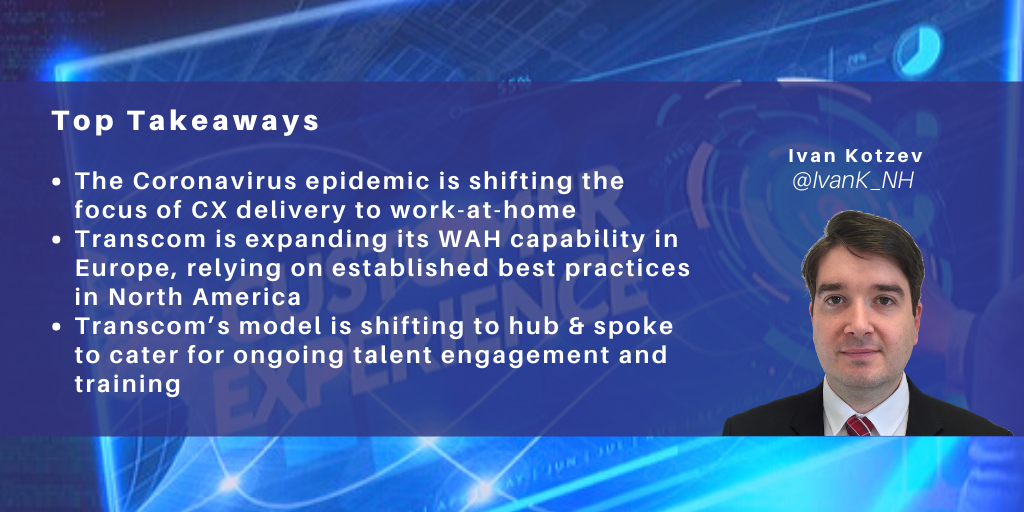Search posts by keywords:
Filter posts by author:
Related Reports
Related NEAT Reports
Other blog posts
posted on Feb 28, 2020 by Ivan Kotzev

As businesses brace for the effects of the Covid-19 virus, one direct impact is already happening: the mandatory shift to work-at-home (WAH) in China created the world’s biggest remote working experiment. In CX services, this health hazard is putting the WAH model top of mind for both providers and clients. While virtual work has been gaining traction in the last few years, this external factor can now trigger its global expansion.
WAH shows significant recent growth
The first WAH agents in CX services started in the late 1990s in the U.S. but this has remained a relatively small proportion of the workforce – just 5-10% for the major CX services providers. Since around 2016, in U.S. and Canada, it has attracted interest from new clients such as utility and energy companies and greater focus by CX services suppliers. These two markets represent between 80% and 85% of the global WAH population. For CX services vendors, the acceleration of WAH has come as a response to saturated urban markets, low national unemployment rates, minimum wage increases in certain states and Canadian provinces, and the demand for specialized talent.
Since 2018, Transcom saw the trend in the market and decided to change all its North American operations to virtual working, also hiring a practice leader in early 2019. Currently, it has ~1k full-time employees in 33 U.S. states and six Canadian provinces supporting e-commerce & retail, consumer electronics, telecom, travel, and SME clients with customer care and technical support services, primarily over voice as well as email and chat.
Lessons from Transcom
Transcom has approximately 14 years of experience in work-at-home delivery, starting initially in Europe. It has developed a dedicated WAH recruitment approach with skill-based testing, technical skills and digital literacy exams, scenario and voice analysis, behavioral and competency-based interviews, and background I9 checks, where permitted. It hires only 5-10% of applicants, with the highest throughput results from its referral program. For training, it uses virtual training to replicate different aspects of classroom training with instructor-led and self-paced content. The company has COPC certification for all its WAH employees, covering coaching, monitoring, outlier management, and adopting various incentives such as pay-for-performance, schedule flexibility, and career advancement.
Transcom’s distributed agent infrastructure enables a locked-down virtual desktop environment. The company tests the VPN connectivity between Transcom, the agent machine, and the client’s data centers to ensure the quality of the connectivity from point-to-point. For security, it employs two-factor authentication, no agent administrative rights, limited USB devices, user and computer Group Policy Object, and PCoIP session management and tuning. For its flagship consumer electronics client, it supplies the agent computer.
Clear benefits and new challenges
The WAH model offers labor cost arbitrage opportunities, better talent retention, and adds resources with different skillsets, typically higher educational attainment, and increasingly younger agents from the millennial generation who prioritize flexibility. The model also provides business continuity and disaster recovery (as with the current virus threat).
For clients, the virtual workforce gives significant scalability during peak seasons. For example, for a multinational e-commerce and retail brand which had a peak Christmas 2019 period with ~37K emails and hundreds of social media posts accumulated in a few days, the backlog challenged the 50-strong support team. Transcom recruited and trained 50 additional employees (200% flex up) on a temporary basis in three business days, delivering the staffing before the Christmas holiday and sustaining it for ~30 days until volumes returned to normal. The company delivered 12% CSAT improvement and mitigation of negative publicity for the brand.
In addition to the traditional challenges with security and data protection, the increasing complexity of work drives the need for another level of onsite employee engagement. Transcom is evolving WAH to a ‘community approach’ where it hires people virtually around a hub such as a coworking space or college campus to conduct ongoing monthly skills training.
Global reach
More and more companies now understand that virtual work offers a dynamic and flexible way of working with access to their target talent. Virtual working in CX services is expanding in new countries such as U.A.E. (Sutherland), Scotland (SYKES), Germany (Webhelp), Colombia (Teleperformance), India (Tech Mahindra and Teleperformance), and Japan (Teleperformance).
In 2020, Transcom is expanding its WAH agents to Germany for onshore, and Poland, Croatia, and Serbia for nearshore German. It is integrating its operational best practices and technology while relying on the local market presence and HR expertise. The company is attracting interest from new economy brands, for example in travel, usually influenced by young leadership familiar with the model in their operations.
For the U.S. market, Transcom is offering its ‘community approach’ targeting premium segment white-glove support that can be dynamically localized around retail stores or high-value customer concentrations. With the service, it targets automotive brands, retail, software and consumer electronics manufacturers.
